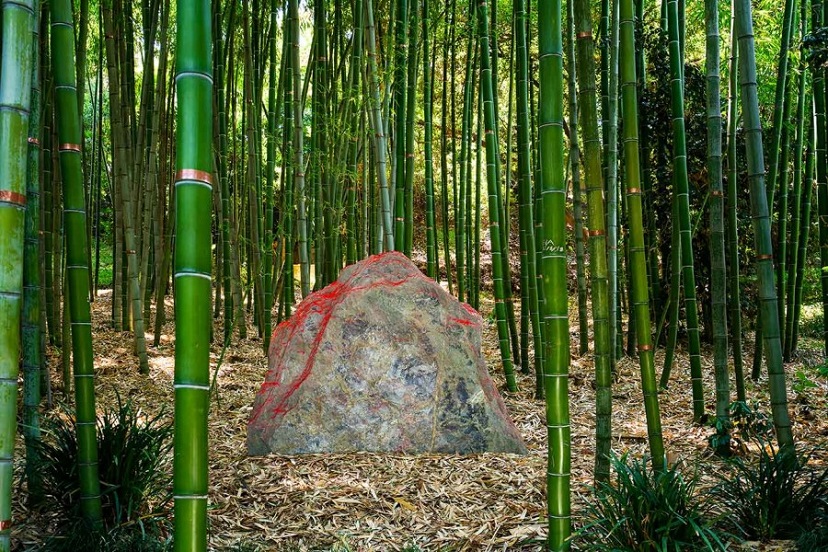
Installation view of “Red Earth” by Lita Albuquerque. The Huntington Library, Art Museum, and Botanical Gardens. Photo by Karl Puchlik, courtesy of the artist.
A new site-specific artwork by Lita Albuquerque, “Red Earth,” greets visitors at The Huntington Library, Art Museum, and Botanical Gardens as garden areas reopen after a closure of more than three months as a result of the COVID-19 pandemic. Originally scheduled to go on view in March, the temporary installation centers around a boulder capped with bright red pigment placed among towering bamboo in a grove of the Japanese Garden. It is exclusive to this particular time and place and is “a stand-in for what I am hoping the visitor to feel, a sense of calm in the midst of chaos,” Albuquerque said. “Red Earth,” which closes Nov. 2, was commissioned as a part of The Huntington’s Centennial Celebration.
The work features an approximately three-ton slab of rock surrounded by bamboo stalks that are affixed with copper bands that glint under leaf-filtered sunlight. Visitors to the Japanese Garden are drawn to the installation by vibrant red disks placed along the paths leading toward “Red Earth.”
“Lita’s sensitive response to The Huntington context is both beautiful and profound, and I suspect that ‘Red Earth’ will also delight visitors with an element of surprise,” said Robert Hori, the Botanical Gardens’ cultural curator and project lead. “I’m thrilled that we are able to bring this work to life at last.”
Albuquerque said of the work: “2020 is the year of perfect vision. We are in a time of expanded perception where we are shifting from a perspective that is human to one of the human in the cosmos. I have placed ‘Red Earth’ in this intimate setting, in the heart of the bamboo grove of the Japanese Garden at The Huntington, to represent the earth—the heart even—of the planet in its stillness. The copper rings around the bamboo are flickering lights in constant motion, dancing with sunlight and wind. It is through that stillness that we can discover the motion of the cosmos and our place within it. ‘Red Earth’ slows down the present to intensify the time that is passing. Where the boulder sits is where the stillness of the human lives.”
Lita Albuquerque is an internationally renowned installation and environmental artist, painter, and sculptor. She was born in Santa Monica, CA, and raised in Tunisia, North Africa, and France. In the 1970s, Albuquerque emerged on the California art scene as part of the Light and Space movement and was widely celebrated for her epic and poetic ephemeral pigment pieces created for desert sites. She gained national attention in the late 1970s with her installations pertaining to mapping, identity, and the cosmos, executed in the natural landscape. She represented the United States at the Sixth International Cairo Biennale, where she was awarded the Biennale’s top prize. Albuquerque has also been the recipient of the National Science Foundation Artist Grant Program for the artwork, “Stellar Axis: Antarctica,” which culminated in the first and largest ephemeral artwork created on that continent; three National Endowment for the Arts Art in Public Places awards; an NEA Individual Fellowship grant; a fellowship from the Civitella Ranieri Foundation; the 2019 Laguna Art Museum Wendt Artist of the Year Award; and MOCA’s Distinguished Women in the Arts award. Recent major exhibitions include Desert X AlUla, Saudi Arabia; the 2018 Art Safiental Biennial, Switzerland; “20/20: Accelerando” at USC Fisher Museum of Art; and the Getty Museum’s Pacific Standard Time Performance and Public Art Festival. Her work is in the collections of the Getty Trust, LACMA, the Metropolitan Museum of Art, MOCA, and the Whitney Museum of American Art, among others. She is on the core faculty of the Graduate Art Program at Art Center College of Design, Pasadena, and is represented in Los Angeles by Kohn Gallery.
The Huntington reopens most of its gardens on July 1 to visitors with advance tickets (and opened on June 17 to Huntington members with advance tickets). More information is available at huntington.org.
The Huntington’s Centennial Celebration is made possible by the generous support of Avery and Andrew Barth, Terri and Jerry Kohl, and Lisa and Tim Sloan.












